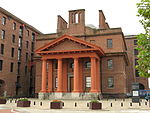Tate Liverpool
1988 establishments in EnglandArt museums and galleries in MerseysideArt museums established in 1988Commons link is defined as the pagenameModern art museums in the United Kingdom ... and 5 more
Museums in LiverpoolMuseums sponsored by the Department for Digital, Culture, Media and SportTate galleriesTourist attractions in LiverpoolUse British English from August 2015

Tate Liverpool is an art gallery and museum in Liverpool, Merseyside, England, and part of Tate, along with Tate St Ives, Cornwall, Tate Britain, London, and Tate Modern, London. The museum was an initiative of the Merseyside Development Corporation. Tate Liverpool was created to display work from the Tate Collection which comprises the national collection of British art from the year 1500 to the present day, and international modern art. The gallery also has a programme of temporary exhibitions. Until 2003, Tate Liverpool was the largest gallery of modern and contemporary art in the UK outside London.
Excerpt from the Wikipedia article Tate Liverpool (License: CC BY-SA 3.0, Authors, Images).Tate Liverpool
Hartley's Bridge, Liverpool Ropewalks
Geographical coordinates (GPS) Address Nearby Places Show on map
Geographical coordinates (GPS)
| Latitude | Longitude |
|---|---|
| N 53.401 ° | E -2.994 ° |
Address
Hartley's Bridge
Hartley's Bridge
L3 4BB Liverpool, Ropewalks
England, United Kingdom
Open on Google Maps









